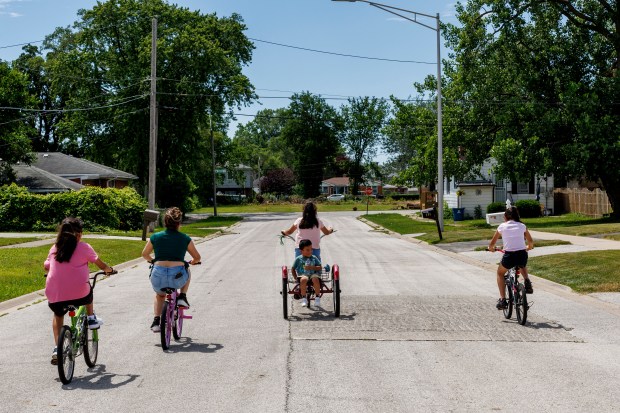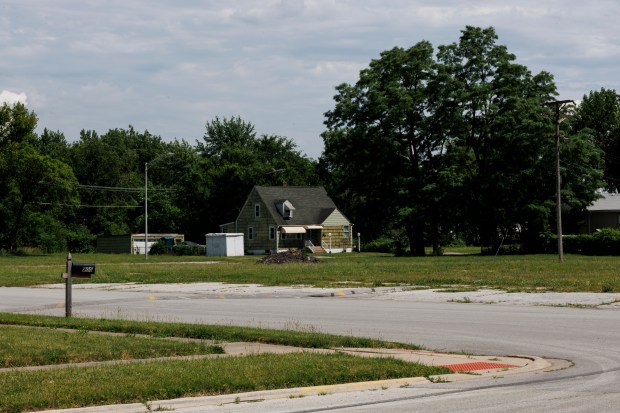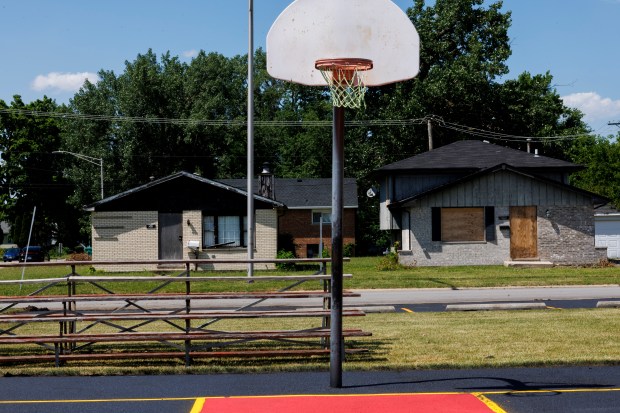Historic property tax increases will hit south suburban homeowners’ mailboxes in the coming weeks, according to a new analysis from the Cook County treasurer’s office that found median tax bills there are rising by 19.9% compared with last year, the largest jump in the last 29 years.
According to the report, more than 327,500 suburban homeowners who live south of North Avenue will see higher bills this year. About 107,000 south suburban homeowners will see lower bills.
In Park Forest, where the median bill is up by $2,567 to $7,152, Mayor Joseph Woods called the increases a “catastrophe” for homeowners and said the village is working to influence policy changes at the county and state levels while seeking out grant funding to avoid having to levy more taxes at the village level.
“We know that there seems to be an unfairness or inequity in regards to the way, you know, properties are assessed,” Woods said in an interview Wednesday. “So we’re looking at every option and trying to lobby everyone.”
The village is split between Cook County and Will County. Woods said the difference in taxes is stark depending on which side of the border people live.
More than a dozen Cook County suburbs have median bills that have increased by more than 30%. That includes Dixmoor, where the median tax bill for homeowners jumped from $1,073 last year to $1,950 this year, and Hazel Crest, where the median bill jumped by $1,586 to $5,651.
Some frustrated residents also place heavy blame on the county, including government worker Patricia Harris, who said she believes her home on Fifth Avenue in Phoenix was unfairly assessed compared to her neighbors.
Cook County Assessor Fritz Kaegi valued her house, which she has lived in since 1997, at $140,000, almost 170% higher than it was the year before. In contrast, two other homes within two blocks that Harris said are “nearly identical” to hers, having been built by the same architect around the same time, were assessed at $65,000.
“You can clearly see it’s the same house,” Harris said in an interview Wednesday. “How can mine be assessed at so much more?”
Harris submitted an appeal, which the assessor rejected. She said she plans to appeal again, but is frustrated with the number of steps she has to go through to get relief. “They initially tell you no, then you go back and appeal that, and then it goes before the (Board of Review), and then they make adjustments. Why do people have to go through that?”
The difference in her bill was even more stark. It jumped from $1,612 last year to a total of $8,855. The median bill in Phoenix nearly doubled, from $900 to $1,744, according to the treasurer. Harris is hoping to scrape by for the next two years until she is old enough to potentially qualify for a senior exemption.
“Homeowners should not have to go through the mental stress that they’re going through, just wondering if they’re going to be able to still afford their home,” Harris said. “You’re taking people from their homes.”
Meanwhile, owners of industrial or commercial properties such as factories, stores, or offices in the south suburbs saw their median bill fall by about 8.5% year over year, the report found.
Countywide, property owners are paying $700 million more in taxes, a 4% increase compared to last year, just below the 4.1% rate of inflation.
After years of delays, the county’s taxing agencies — the assessor, Board of Review, clerk and treasurer — have managed to get bills out on time. Nearly all bills are now posted on the treasurer’s website and must be paid by Aug 1.
There is an exception: the assessor miscalculated land values for more than 4,400 homes in the south and southwest suburbs, leading to whopping over-assessments for homes on bigger plots of land.
“We will process Certificates of Error for these properties,” Kaegi spokesman Christian Belanger said. “The property values will be corrected in time for the homeowners affected to receive accurate tax bills” that will be mailed on schedule in early July.

Several factors play into bill increases. Levies set by local villages, schools and park districts are a major one. Countywide, school districts increased their levies the most by dollar amount, seeking $573 million more than in 2022, an increase of just over 6%, according to the analysis.
Kaegi’s valuations are another major factor. The south suburbs just went through their triennial reassessment last year, where homes and businesses were assigned fresh values by the assessor and where property owners could appeal those values to the county’s Board of Review.
The overall assessed value of residential properties “rose significantly” in the Southland, while commercial values dropped, the study from Treasurer Maria Pappas’ research arm found. Successful appeals to the Board of Review “recalibrated” values set by Kaegi’s office, both the treasurer and assessor found.
The board “shaved more than 21% off the total assessed value of commercial and industrial properties whose owners appealed,” the treasurer’s report found. They cut the total value of residential appeals by about 4.4%.
The largest burden shifts came in Bloom and Stickney townships, according to the assessor, where the residential share of assessed value increased by 6 percentage points after appeals at the Board of Review. After those appeals, Chicago Heights, Calumet City, Alsip, Dolton and Justice all saw significant shifts.
The assessor’s COVID-19 adjustment — which reduced values by about 10% — also ended in the Southland. At the same time, the hot streak in the housing market has fueled a boom in sale prices and values compared to the assessment three years ago. It’s like a coupon expiring at the same time the price of a good increases. The same phenomenon helped fuel big tax bills in the north suburbs last year.
Taxes are a zero-sum game. When one property owner pays less, others make up the difference. Taken together, new assessments, successful commercial appeals and the end of the COVID adjustment drove a shift in the tax burden and boost in bills: nearly 74% of homeowners will owe more, while nearly 70% of commercial property owners will pay less.
Other fresh elements came into play for bills this year. Thanks to those rising home values, nearly 4,200 south suburban homeowners who were previously receiving enough tax breaks via exemptions to pay $0 in taxes will have a bill this year. Those bills will range from just a few cents to nearly $11,000.
While probably an unwelcome change for the homeowners skating by, it’s a relief for neighbors who previously had to pay more in taxes to make up the difference. Municipal leaders, too, prefer a broad tax base to spread out the burden of their levies.
Rising property values also led to a drop in overall tax rates in the south suburbs, where rates are already some of the highest in the country.
That rate drop didn’t trigger a tax break, though. Park Forest, for example, saw its tax rate dip from 43.5% in 2022 to 23.6% in 2023. But because residential values boomed while commercial values fell, commercial property owners got a break and homeowners got stuck with bigger bills. The median tax on businesses was halved, from $14,953 to $7,175, while homeowners’ bills increased by 56%, to $7,152, the treasurer’s report found. That drop in the rate, though, could make the village slightly more attractive for homeowners and businesses to move in.

Another fresh element: Kaegi closed what he considered an “apartment loophole,” where buildings with both residential and commercial uses were being assessed as if they were all-residential. Commercial buildings are assessed at 25% of their market value, while homes and apartments are assessed at 10% of their market value.
Kaegi moved to split up certain of those buildings, driving up significant reassessments in the south and southwest suburbs. If a mixed-use building with at least seven units had a square footage between 20,000 and 99,999 square feet and 35% or more of that square footage is used for commercial purposes, Kaegi gave it a new assessment with both commercial and residential rates.
The treasurer’s analysis found Kaegi closed the “loophole” on 174 properties in the Southland. Their median tax bill shot up 43.6%, the analysis found. The closure of those loopholes will have an even bigger impact in Chicago, which is currently being reassessed.
“If you don’t like what’s going on, you need to get up, go to the polls and voice your concerns,” Pappas said during an interview Wednesday. “Doing nothing creates this problem.”
She also said residents should take a longer look at the line items on their bill to have a better idea of what their money is going toward.
“For decades now, the south suburbs have been like a poster child for inequities in the state’s property tax system, and after 30 years of those just going up, well, they just got worse.”
aquig@chicagotribune.com
ostevens@chicagotribune.com




